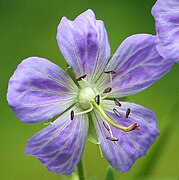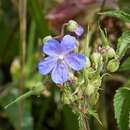Associations
provided by BioImages, the virtual fieldguide, UK
Foodplant / open feeder
larva of Aphthona nigriceps grazes on leaf of Geranium pratense
Foodplant / saprobe
hypophyllous fruitbody of Efibulobasidium albescens is saprobic on dead stem of Geranium pratense
In Great Britain and/or Ireland:
Foodplant / open feeder
larva of Limobius borealis grazes on leaf of Geranium pratense
Other: major host/prey
Foodplant / saprobe
scattered, erumpent apothecium of Pirottaea paupercula is saprobic on stem of Geranium pratense
Foodplant / parasite
sporangium of Plasmopara pusilla parasitises live Geranium pratense
Other: major host/prey
Foodplant / parasite
Podosphaera fugax parasitises live Geranium pratense
Foodplant / feeds on
larva of Protoemphytus carpini feeds on leaf of Geranium pratense
Other: major host/prey
Foodplant / spot causer
hypophyllous colony of Ramularia anamorph of Ramularia geranii causes spots on live leaf of Geranium pratense
Foodplant / parasite
hypophyllous telium of Uromyces geranii parasitises live leaf of Geranium pratense
Foodplant / feeds on
larva of Zacladus geranii feeds on Geranium pratense
Comments
provided by eFloras
Geranium pratense shares with species 34-36 staminal filaments with a broadly triangular base and an abruptly narrowed apex. The triangular base is as wide as long and should not be confused with slightly dilated bases of other Chinese species, which are distinctively longer than wide. Leaf blades of G. pratense are deeply divided with a deeper main and second sinus. The extreme leaf-divided forms have been segregated as G. affine or G. transbaicalicum. However, these plants can be found along the area of G. pratense intermixed with normal forms. Petal color is usually bluish but it can also be white or purplish. Petal color is not related to leaf division or other characters and seems to have little taxonomic importance. The variability of this species in the Himalayas should be studied more deeply.
- license
- cc-by-nc-sa-3.0
- copyright
- Missouri Botanical Garden, 4344 Shaw Boulevard, St. Louis, MO, 63110 USA
Description
provided by eFloras
Perennials. Rootstock ± horizontal, 0.7-2 cm in diam., not tuberculate, with thickened roots along rootstock. Stem 23-100(-150) cm tall, erect, not rooting at nodes, with 0.1-1.7 mm retrorse to patent nonglandular trichomes and sometimes 0.2-1.2 mm patent glandular trichomes. Stipules lanceolate, distinct. Leaves opposite; petiole with 0.3-0.9 mm retrorse to patent nonglandular trichomes and sometimes 0.5-1.1 mm patent glandular trichomes; leaf blade (4.2-)6.2-11.5 cm, palmately cleft, ratio of main sinus/middle segment length = (0.81-)0.86-0.94, pilose with appressed nonglandular trichomes; segments (5 or)7(or 9), rhombic, 2.2-7.5 mm wide at base, 10-30-lobed in distal half, ratio of second sinus/middle segment length = 0.15-0.48. Cymules solitary, 2-flowered; peduncle 1.3-12 cm. Pedicel 0.3-2.5 cm, with 0.2-0.4 mm patent to retrorse nonglandular trichomes and 0.4-1.2 mm patent glandular trichomes; bracteoles lanceolate. Sepals (0.7-)1-1.2 cm, mucro (1.7-)2.2-3.9 mm, ratio of mucro/sepal length = 0.16-0.39, outside with 0.2-0.9 mm patent nonglandular trichomes and 0.3-1 mm patent glandular trichomes, inside glabrous. Petals bluish or sometimes purplish or white, (1.3-)1.5-1.9(-2.4) cm, erect to patent, both surfaces glabrous, margin basally ciliate, apex rounded. Staminal filaments pinkish, lanceolate with a broadly triangular base and an abruptly narrowed apex, both sides glabrous but proximal third with 0.2-0.6 mm cilia; anthers dark violet to bluish black, 1.8-3.1 mm. Nectaries 5, hemispheric, abaxially glabrous, apex with a tuft of trichomes. Stigma green to pinkish. Fruit 3-3.7 cm, reflexed when immature; mericarps smooth but usually with 1 or 2 transversal veins at apex, with a basal callus, with 0.3-0.7 mm ± appressed nonglandular trichomes and usually only apically with 0.2-0.9 mm patent glandular trichomes; rostrum 2.1-2.9 cm, with a 7-9 mm narrowed apex; stigmatic remains 2-3 mm. Seeds 3-3.6 mm. Fl. Jun-Jul, fr. Jul-Aug. 2n = 28.
- license
- cc-by-nc-sa-3.0
- copyright
- Missouri Botanical Garden, 4344 Shaw Boulevard, St. Louis, MO, 63110 USA
Distribution
provided by eFloras
Europe, C. Asia, Himalaya (Kashmir to Nepal).
- license
- cc-by-nc-sa-3.0
- copyright
- Missouri Botanical Garden, 4344 Shaw Boulevard, St. Louis, MO, 63110 USA
Distribution
provided by eFloras
Gansu, Nei Mongol, Qinghai, Shanxi, NW Sichuan, Xinjiang, E Xizang [Afghanistan, Kashmir, Kazakhstan, Kyrgyzstan, Mongolia, Nepal, Pakistan, Russia, Tajikistan, Turkmenistan, Uzbekistan; Europe].
- license
- cc-by-nc-sa-3.0
- copyright
- Missouri Botanical Garden, 4344 Shaw Boulevard, St. Louis, MO, 63110 USA
Elevation Range
provided by eFloras
2200-3500 m
- license
- cc-by-nc-sa-3.0
- copyright
- Missouri Botanical Garden, 4344 Shaw Boulevard, St. Louis, MO, 63110 USA
Habitat
provided by eFloras
Meadows, subalpine meadows; 1400-4000 m.
- license
- cc-by-nc-sa-3.0
- copyright
- Missouri Botanical Garden, 4344 Shaw Boulevard, St. Louis, MO, 63110 USA
Synonym
provided by eFloras
Geranium affine Ledebour (1831), not Poiret (1812); G. pratense var. affine C. C. Huang & L. R. Xu; G. transbaicalicum Sergievskaja.
- license
- cc-by-nc-sa-3.0
- copyright
- Missouri Botanical Garden, 4344 Shaw Boulevard, St. Louis, MO, 63110 USA
Comprehensive Description
provided by North American Flora
Geranium pratense L. Sp. PI. 681. 1753. v
Perennial, thecaudex simple. Stem solitary, 3-6.5 dm. long, finely retrorse-pubescent, some of the hairs often gland-tipped ; leaf-blades pentagonal in outline, 4-12 cm. wide, finely hirsute, 5-parted, the divisions sharply incised and toothed, the ultimate segments narrowly lanceolate; pedicels glandular-hirsute; sepals awn-tipped, the outer ones 11-14 mm. long, the bodies elliptic to lanceolate, hirsute; petals purple, 14-21 mm. long; stylecolumn 17-19 mm. long, glandular-hirsute ; carpel-bodies 4-4.5 mm. long, minutely pubescent ; seeds minutely reticulate.
Type locality : Europe.
Distribution : Massachusetts. Introduced from Europe.
- bibliographic citation
- John Kunkel Small, Lenda Tracy Hanks, Nathaniel Lord Britton. 1907. GERANIALES, GERANIACEAE, OXALIDACEAE, LINACEAE, ERYTHROXYLACEAE. North American flora. vol 25(1). New York Botanical Garden, New York, NY
Geranium pratense
provided by wikipedia EN
Geranium pratense, the meadow crane's-bill[1] or meadow geranium,[2] is a species of flowering plant in the family Geraniaceae, native to Europe and Asia.[3] Forming a clump up to 1 m (3.3 ft) broad, it is a herbaceous perennial with hairy stems and lax saucer-shaped blooms of pale violet. It is extremely hardy to at least −20 °C (−4 °F), reflecting its origins in the Altai Mountains of central Asia.[4]
The leaves are deeply divided into 7-9 lobes and 3-6 inch wide and the flowers are pale blue, although getting paler into the centre. The flowers have 5 petals, which sometimes have veins. The stamens have pink-purple stalks with dark purple anthers.
Several cultivars are available for garden use, of which 'Mrs Kendall Clark'[5] and 'Plenum Violaceum'[6] have gained the Royal Horticultural Society's Award of Garden Merit.[7]
References

- license
- cc-by-sa-3.0
- copyright
- Wikipedia authors and editors
Geranium pratense: Brief Summary
provided by wikipedia EN
Geranium pratense, the meadow crane's-bill or meadow geranium, is a species of flowering plant in the family Geraniaceae, native to Europe and Asia. Forming a clump up to 1 m (3.3 ft) broad, it is a herbaceous perennial with hairy stems and lax saucer-shaped blooms of pale violet. It is extremely hardy to at least −20 °C (−4 °F), reflecting its origins in the Altai Mountains of central Asia.
The leaves are deeply divided into 7-9 lobes and 3-6 inch wide and the flowers are pale blue, although getting paler into the centre. The flowers have 5 petals, which sometimes have veins. The stamens have pink-purple stalks with dark purple anthers.
Several cultivars are available for garden use, of which 'Mrs Kendall Clark' and 'Plenum Violaceum' have gained the Royal Horticultural Society's Award of Garden Merit.

'Mrs Kendal Clark'
- license
- cc-by-sa-3.0
- copyright
- Wikipedia authors and editors


